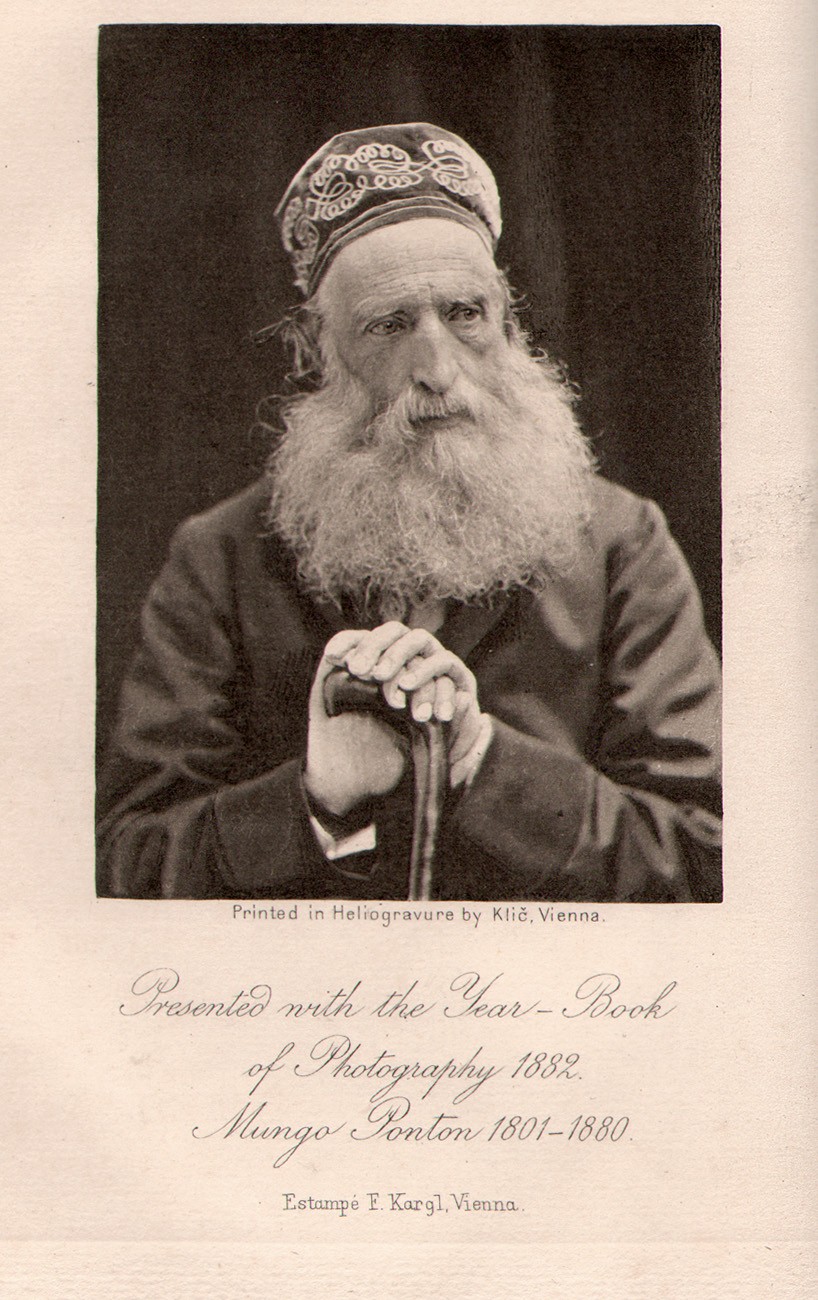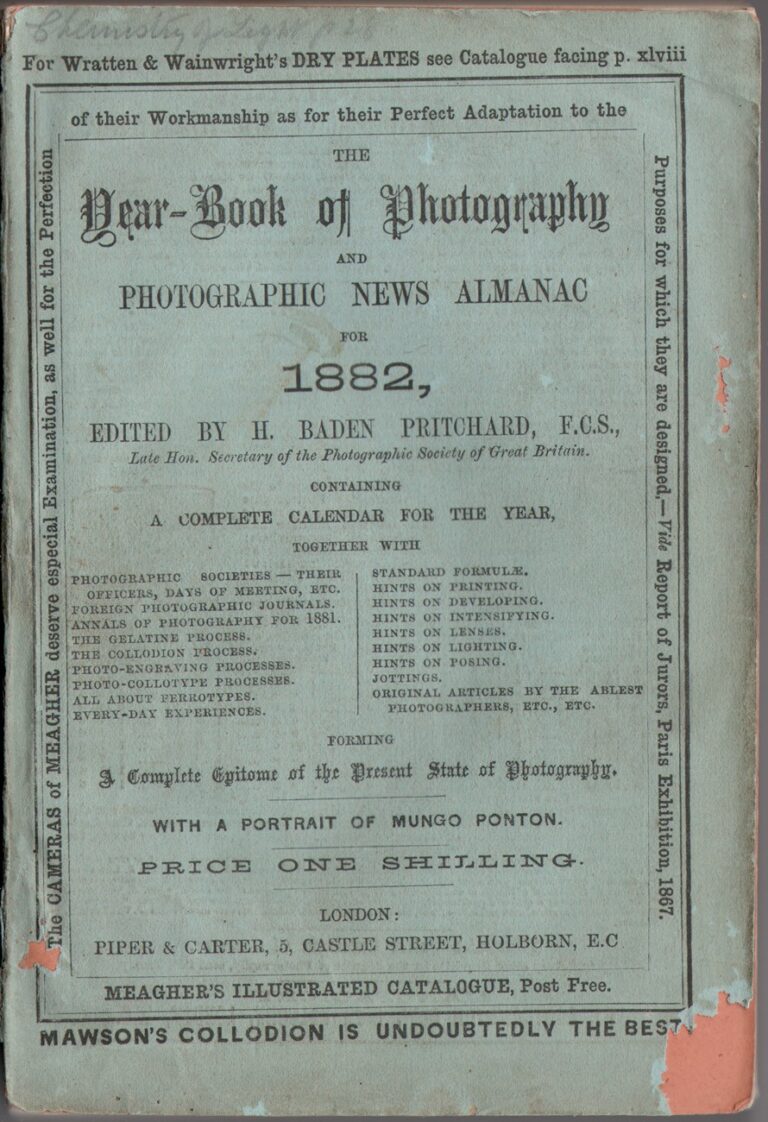
Mungo Ponton: 1801-1880
This early example of a hand-pulled Karl Klič heliogravure bears the following inscription within the plate mark:
Printed in Heliogravure by Klič, Vienna.
Presented with the Year-Book of Photography 1882.
Mungo Ponton 1801-1880.
Estampé F. Kargl, Vienna. (Engraving by)
Due to this being a bound photogravure, our scan shows only part of the photogravure support, with the plate mark indentation visible only at bottom margin of image.
A Lasting Impression of Mungo Ponton
This portrait of the Scottish photographic inventor Mungo Ponton is notable for the fact of Ponton’s contributions to the history of Photography as well as it being the first example of a Karl Klič heliogravure (photogravure) published in Great Britain in 1881.
Mungo Ponton: 1801-1880
The Scotsman Mungo Ponton, 1801-1880, credited as the father of permanent photography, made the discovery in 1839 while experimenting with silver chromate “that paper coated with potassium dichromate-then called bichromate —was sensitive to light.” 1.
This remembrance of Ponton appeared nine months after his passing in The British Journal of Photography:
“Mungo Ponton was born at Balgreen, near Edinburgh, in the year 1801. He was educated for the legal profession, and, in due course, became a writer to the signet. He was one of the founders of the National Bank of Scotland, and it was in his office that the plans were matured for the establishment of that institution. He held the office of legal adviser to the bank, and subsequently that of secretary. The strain of the double duties thus imposed on him proved too much for his strength and a serious attack of illness compelled him to retire from active life while yet comparatively a young man. Since that time he continued more or loss of an invalid, but his intensely-active mind found congenial occupation in scientific and literary pursuits. He discovered the peculiar effect of light on gelatine when treated with the bichromate of potash, which was afterwards practically applied in the autotype process. Indeed, it is upon the sensitiveness of this salt to light, under certain conditions, that all the processes of permanent printing of the present day are based; and this discovery of his consequently marks the commencement of an era in photography, and renders his name as closely connected with the history of that art as are those of Niepce, Daguerre, and Talbot. It was in 1839—the very year in which the wonderful process of Daguerre was announced to the world—that Mungo Ponton called attention to bichromate of potash as a photographic agent, and described a process—the foundation of every subsequent permanent printing process—whereby, through that agent, durable impressions on paper might be produced. This discovery, which had been first announced to the Scottish Society of Arts on the 29th May, 1839, was given to the world in the Edinburgh New Philosophical Journal, vol. xxvii., 1839, under the title—Notice of a Cheap and Simple. Method of Preparing Paper for Photographic Drawing. * * * He was the first who employed the photographic method for registering automatically the fluctuations in thermometers and other instruments, and for this invention he received also the silver medal of the same (the Scottish Society of Arts) society in 1845.” Mr. Ponton also experimented, we are informed, at a very early date in the production of enamel pictures, using plates of unbaked porcelain. In this branch of photography he secured a fair amount of success, and may be considered the founder of enamel photography.” 2.
Debut: a Klič Photogravure for England
Writing later in his History of Photography in 1905, and coincidentally or not paying lasting and permanent tribute to Ponton’s accomplishments via the groundbreaking photogravure process perfected by Karl Klič (1841-1926) was Josef Maria Eder. Eder contacted Klič in Vienna a scant two years after his photogravure process was revealed in 1879 in order to secure what would turn out to be the very first published example of his process in England on behalf of London’s Yearbook of Photography for 1882:
“The English journals published Klič’s invention in 1881. The editor of the Photographic News and of the Yearbook of Photography, London, Captain Baden-Pritchard, requested this author to order from Klič a heliogravure of Mungo Ponton’s portrait and 2,000 impressions from it. This work appeared as an insert to the Yearbook for 1882 with the credit line, “Heliogravure by Klič, Vienna.” This was Klič’s debut in England, and it made the craftsmen there acquainted with his work.” 3.
Earlier, in the same volume, Eder explains the significance of Klič’s photogravure process:
“The zenith of heliogravure by the etching method for beauty of results, as well as for sureness and rapidity of production, was reached by the painter and newspaper artist Karl Klič, at Vienna, who combined the pigment transfer process on grained copper plates with the etching process, and thus outstripped his predecessors. Klič is the creator of modern photogravure with aquatint grain on copper plates by means of the transfer of a pigment image and etching in iron chloride baths of various strengths, in which he etched the half-tone picture to different graduated depths.” 4.
Making note of the photograph itself, unattributed but which may have been taken by Klič in the last decade of Ponton’s life, (5.) editor Henry Baden-Pritchard or another author wrote the following in London’s Yearbook of Photography for 1882:
“We ought to say a word about our portrait of Mungo-Ponton, an Englishman who may well be termed the discoverer of permanent photographic printing, for he it was who proposed, in 1839, the employment of bichromate in photography. Klic’s is an etching process upon copper, an imprint from a carbon diapositive being secured upon that metal. The mode of preparing the copper is a secret, but we may mention that the process is so quick, that within four or five days an engraved plate may be produced of considerable dimensions. Of the quality of the printing our readers can judge for themselves. Suffice it to say, the process is an inexpensive one, and that during the past year alone, no less than three hundred photo-engravings were produced. ” 6.
Notes
1. Dichromate Processes: Carbon Printing: in: The Keepers of Light: by William Crawford: Morgan & Morgan: Dobbs Ferry, New York: 1979: p. 69
2. The Late Mungo Ponton: from: Proceedings of the Royal Society of Edinburgh: in: The British Journal of Photography: No. 1097, Vol. XXVIII, May 13, 1881: p. 246
3. Klič’s method of Photogravure (1879):in: Josef Maria Eder: History of Photography: Translated by Edward Epstean: Columbia University Press: New York: 1945: p. 599
4. Ibid: p. 596
5. Klič biography: in: Encyclopedia of nineteenth-century photography, Volume 1: by John Hannavy: CRC Press, 2008: p. 800
6. Annals of Photography for 1881: in: The Year-Book of Photography and Photographic News Almanac for 1882: Edited by H. Baden Pritchard: London: Piper & Carter: 1882: pp. 26-27
